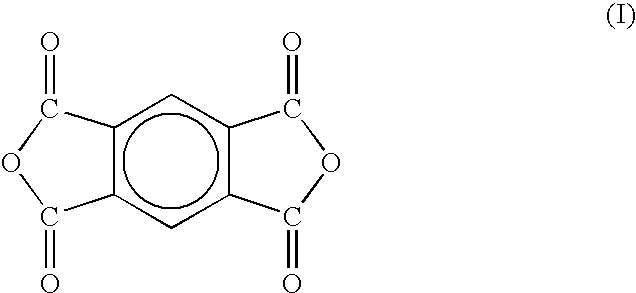Two-stage cure polyimide oligomers
a polyimide oligomer and two-stage cure technology, applied in the direction of adhesives, etc., can solve the problems of high labor intensity and cost, difficult to fabricate low-void composites using this type of chemistry, and raise health and safety concerns
- Summary
- Abstract
- Description
- Claims
- Application Information
AI Technical Summary
Benefits of technology
Problems solved by technology
Method used
Image
Examples
examples
[0074]The subject invention will now be described by reference to the following illustrative examples. The examples are not, however, intended to limit the generally broad scope of the present invention.
[0075]Each example was tested for flexural strength and glass transition temperature in accordance with the following test methods.
Flexural Strength (MPa)—Flexural strength was measured according to ASTM D-790.
Glass Transition Temperature (Tg)—The glass transition temperature was measured at a temperature rising rate of 2° C. / minute in a nitrogen atmosphere using a dynamic mechanical analyzer (DMA).
[0076]Unless otherwise stated, procedures, conditions, etc. detailed below for the preparation of the BPDA / CA / / 3,4′-ODA / BAPP prepreg solution and composites were also used to prepare the remaining prepreg solutions and composites of Examples 9 to 17 in this EXAMPLES section.
examples 1 to 8
BPDA / CA(83 / 34) / / 3,4′-ODA / / BAPP(85 / 15)
[0077]In Examples 1 to 8, components 3,4′-ODA (34.000 g, 0.170 mol), BAPP (12.300 g, 0.030 mol) and NMP (104.15 g) were added to a 500 milliliter (ml) three-neck flask equipped with a mechanical stirrer and a heater. The resulting mixture was completely dissolved to from a solution. BPDA (48.804 g, 0.166 mol) was dispersed in NMP (104.15 g) and the resulting dispersion was added to the solution in the three-neck flask. The resulting mixture was then stirred at a rate of 80 revolutions per minute (rpm) at 60° C. for 8 hours to provide a solution. Finally, a solution of CA (7.616 g, 0.068 mol) in NMP (10.0 g) was added to the solution in the three-neck flask and the resulting mixture stirred at 60° C. for 2 hours. A prepreg solution having a solids content of 30 wt. % and a viscosity of 31 poise was obtained.
[0078]Eight sheets of woven carbon fabric obtained from Cytec Engineered Materials, Inc., 1440 N. Kraemer Blvd., Anaheim, Calif. 92806 (“Cytec...
example 9
BPDA / CA(83 / 34) / / 4,4′-ODA / BAPP(85 / 15)
[0081]In this Example, aromatic diamine 4,4′-ODA was used instead of aromatic diamine 3,4′-ODA. The prepreg solution had a solids content of 30 wt. % and a viscosity of 64 poise. The composite test results are shown in Table 2.
[0082]
TABLE 2Summary of Example 91st step2nd step3rd StepFlexural StrengthTemp.TimeTemp.TimeTemp.Time(MPa)TgExample(° C.)(hr)(° C.)(hr)(° C.)(hr)Ave.S.D.Median(° C.)92501250-3500.5350154514545263
[0083]Example 9 showed an acceptable level of flexural strength, but had a somewhat rough surface indicating less than optimal resin flow. The glass transition temperature of this composite was higher than the average of the above Examples 1 to 8.
PUM
| Property | Measurement | Unit |
|---|---|---|
| viscosity | aaaaa | aaaaa |
| temperatures | aaaaa | aaaaa |
| temperature | aaaaa | aaaaa |
Abstract
Description
Claims
Application Information
 Login to View More
Login to View More - R&D
- Intellectual Property
- Life Sciences
- Materials
- Tech Scout
- Unparalleled Data Quality
- Higher Quality Content
- 60% Fewer Hallucinations
Browse by: Latest US Patents, China's latest patents, Technical Efficacy Thesaurus, Application Domain, Technology Topic, Popular Technical Reports.
© 2025 PatSnap. All rights reserved.Legal|Privacy policy|Modern Slavery Act Transparency Statement|Sitemap|About US| Contact US: help@patsnap.com



